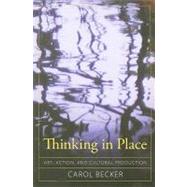Thinking in Place: Art, Action, and Cultural Production
, by Becker,Carol- ISBN: 9781594515972 | 1594515972
- Cover: Nonspecific Binding
- Copyright: 11/30/2009
Thinking in Placeis a meditation on place as a physical as well as a conceptual construct that encompasses both history and memory. The book begins with 'Defining Place,' a piece about the memory of childhood as located in two unique locations'Crown Heights, in Brooklyn, New York, and Hastings, a coal-mining town in Western Pennsylvania. These were the two locations of Becker's childhood and of her multiple dual-identities as Russian Jewish/Polish Catholic, urban/rural and working class/peasant. This essay sets up the underlying premise of the book, which is that writing is the ultimate place of safety and sanity in the midst of the complexity of identity. The second essay is about growing up near the Brooklyn Museum in New York, a place that established for Becker the value of public institutions and thus made possible a long career of working in an art school connected to a great historical museum. This is one of three pieces that takes its location from the pedagogical site of educating artists. The last four essays in the book are specific to site and history. One is located at the site of the My Lai massacre. Another is focused on the production of an archive by indigenous women who survived apartheid South Africa. Another essay begins at Birla House, the place where Gandhi was shot, and focuses on the public image of 'Gandhi's Body,' exploring the idea that the more naked he becomes in appearance, the more powerful he becomes in the world. The final essay is a meditation on the high waters of Venice, a city that is losing ground, literally, each year, but that houses some of the greatest paintings ever painted'a site of dreams, memories, obsessions about the past, filled with premonitions of the future. There are ten essays, and each is unique in style and approach. Each is also passionate in its attempt to translate the experiential into the analytic, and to use each experience to contemplate the evolution of the thought as a potential agent for social change. Read about Carol's thoughts on life, art, and her new book in this interview in The Brooklyn Rail here: Brooklyn Rail Interview







